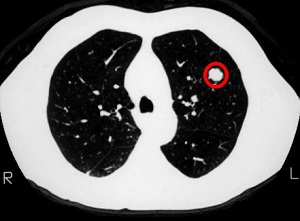SUMMARY: Lung cancer is the second most common cancer in both men and women and accounts for about 14% of all new cancers and 27% of all cancer deaths. The American Cancer Society estimates that for 2019, about 228,150 new cases of lung cancer will be diagnosed and 142,670 patients will die of the disease. Lung cancer is the leading cause of cancer-related mortality in the United States. In the National Lung Screening Trial (NLST) with Low Dose CT (LDCT) screening for lung cancer, there was a 20% reduction in mortality. Following the publication of the results of NLST and NCCN issued guideline in 2011, the United States Preventive Services Task Force (USPSTF) recommended Lung Cancer screening with Low Dose CT scan in high risk patients. CMS in 2015 determined that there was sufficient evidence to reimburse for this preventive service.
Despite the evidence and recommendation along with supportive public policies, screening with LDCT has not been adequately implemented in the US healthcare system. (A low-dose CT scan will typically deliver 1-4 millisieverts of radiation exposure, whereas a conventional CT scan typically delivers between 5-20 millisieverts).Health Care Providers play a key role because LDCT is currently the only cancer screening modality required by CMS to have a shared decision-making conversation with the patient for reimbursement, making it crucial for providers to have knowledge of the screening recommendations, CMS coverage criteria, and evidence for screening. Low Health Care Provider knowledge of the Lung Cancer Screening (LCS) guidelines represents a potential barrier to implementation.
The authors in this study tested the hypothesis that low provider knowledge of Lung Cancer Screening guidelines is associated with less provider-reported screening with LDCT. The researchers from February thru May 2017 surveyed/invited 625 providers who routinely perform health screenings or care for patients at high risk of lung cancer, out of whom responses from 378 providers were analyzed. Health Care Providers were emailed internet-based questionnaire and participating providers included those who practiced general Internal Medicine/Family Medicine, Pulmonology, Hematology/Oncology, and Gynecology, within an academic medical center (Vanderbilt University Medical Center [VUMC]) and its affiliated Veterans Health Administration (VHA), including hospital-based and community-based practices. A medicine Grand Rounds at VUMC focused on Lung Cancer Screening (LCS) prior to this survey. Eligible providers included Attending physicians, Physicians in training, Physician Assistants, and Nurse Practitioners, who reported providing healthcare services to patients aged more than 50 in the year before the study. The questionnaire was terminated if respondents did not meet these criteria. Approximately 47% were Attending physicians, 43% were Physicians in training and 10% were Nurse Practitioners/Physician Assistants. Questionnaire Content included six multiple-choice items based on the USPSTF and CMS coverage criteria for Lung Cancer Screening. They included the following:
1) Initial age of screening eligibility (correct answer: 55 years)
2) Upper age limit at which a patient is no longer eligible for screening (correct answer: either 77 or 80 years)
3) Minimum smoking exposure (correct answer: 30 pack-years)
4) Smoking status (correct answer: current and former smokers)
5) Screening frequency (correct answer: yearly)
6) Screening for patients who were not surgical candidates (correct answer: no)
High LCS knowledge was defined as correctly identifying 3 major criteria to identify screening candidates: initial age of screening eligibility, minimum smoking exposure, and smoking status. Low LCS knowledge was defined as not correctly identifying these 3 criteria. The Primary outcome was self-reported order/referral of LDCT within the past year. Secondary outcomes were self-reported ordering of non-recommended LCS tests such as chest X Ray and sputum cytology.
On analysis it was noted that 59% of the providers reported ordering/referring for LDCT within the past year. Overall 62% of the provider’s demonstrated low LCS knowledge and the odds of ordering/referring for LDCT were 76% lower for providers with low LCS knowledge than for those with high LCS knowledge. Providers with low LCS knowledge had a 2.7 higher odds of ordering a screening chest radiograph, than providers with high LCS knowledge. The ordering/referring rates for LDCT were highest among general Internal Medicine/Primary Care Providers (75.9%), followed by Pulmonologists (74.4%), Hematologists/Oncologists (39.7%), and Gynecologists (2.1%). After adjusting for other variables, all provider types were less likely than general Internists/Primary Care Providers to order/refer for LDCT.
It was concluded that results of this study suggests that the referring provider knowledge of LCS guidelines is low and providers with low guideline knowledge were less likely to order LDCT lung screening. The authors recommended that strategies to advance effective evidence-based LCS should incorporate provider education and healthcare system interventions, to facilitate the appropriate identification of candidates for Lung Cancer Screening. Low Provider Knowledge Is Associated With Less Evidence-Based Lung Cancer Screening. Lewis JA, Chen H, Weaver KE, et al. J Natl Compr Canc Netw 2019;17:339-346

